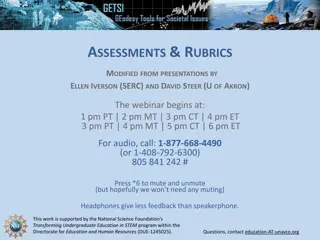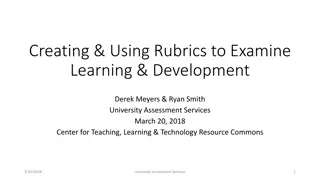Developing and Using Scoring Guides and Rubrics in Assessment
Explore the importance of rubrics and scoring guides in assessment development, understanding different types of rubrics, developing and using them effectively, and addressing bias through objective criteria. Learn how rubrics help in evaluating student responses and providing feedback for improvement.
Download Presentation

Please find below an Image/Link to download the presentation.
The content on the website is provided AS IS for your information and personal use only. It may not be sold, licensed, or shared on other websites without obtaining consent from the author.If you encounter any issues during the download, it is possible that the publisher has removed the file from their server.
You are allowed to download the files provided on this website for personal or commercial use, subject to the condition that they are used lawfully. All files are the property of their respective owners.
The content on the website is provided AS IS for your information and personal use only. It may not be sold, licensed, or shared on other websites without obtaining consent from the author.
E N D
Presentation Transcript
Michigan Assessment Consortium Common Assessment Development Series Module 12 Developing and Using Developing and Using Scoring Guides and Rubrics 1
Narrated By: Narrated By: Bruce Fay Wayne RESA 2
In This Module In This Module Why and when you need rubrics Different kinds of rubrics How to develop a rubric How to use a rubric What scoring guides are How to use scoring guides 3
Subjectivity in Scoring Subjectivity in Scoring No such thing If it s truly subjective, it s just someone s opinion, and is of little or no value to the person being assessed Two definitions 4
The Issue is Bias The Issue is Bias Use rubrics and scoring guides to have more objective and transparent criteria Use criteria to make quality work visible to students 5
What is a Rubric? What is a Rubric? guidelines, rules, or principles by which student responses, products, or performances are judged. They describe what to look for in student performances or products to judge quality. Scoring Rubrics in the Classroom, Judith Arter and Jay McTighe, page 4 6
Items that Require a Items that Require a Scoring Guide Scoring Guide Anything that isn t multiple choice If a human scorer needs to make a decision about a score, a rubric or scoring guide is needed 7
Where Do Rubrics Fit? Where Do Rubrics Fit? Almost Everywhere! 8
Scoring an Assessment Item Scoring an Assessment Item Determine if student meets criteria Use assessment results instructionally Inform students about quality of work and areas for improvement Efficient for teachers See patterns and trends 10
First Consider First Consider Checklists Performance lists 11
Checklists Checklists Simple task Present or not present Students know ahead of time 12
Performance Lists Performance Lists Two or more aspects Quality aspect for each aspect Common scale, such as Sometimes , Always , or Never Unique scale for each aspect 13
Rubric Rubric Assessment task more complex Levels of quality need to be distinguished Multiple scorers involved 14
Reliability of Rubric and Reliability of Rubric and Scoring Guide Scoring Guide Reasonable Appropriate Aligned Consistent and fairly applied 15
Varieties of Rubrics Varieties of Rubrics Different types Appropriate uses Typical scoring ranges 16
Rubric Properties Rubric Properties Holistic Analytic Generic A B Task Specific C D 17
Rubric Properties Rubric Properties Holistic Analytic Generic A B Task Specific C D 18
Rubric Properties Rubric Properties Holistic Analytic Generic A B Task Specific C D 19
Rubric Properties Rubric Properties Holistic Analytic Generic A B Task Specific C D 20
Rubric Properties Rubric Properties Holistic Analytic Generic A B Task Specific C D 21
Rubric Types Rubric Types A. Generic Holistic B. Generic Analytic C. Task Specific Holistic D. Task Specific Analytic Ex: NWREL 6+1 Traits Writing Rubric 22
Holistic Rubrics Holistic Rubrics - - Strengths Strengths Provide a quick, overall rating of quality Judge the impact of a product or performance Use for Summative or large-scale assessment 23
Holistic Rubrics Holistic Rubrics - - Limitations Limitations May lack the diagnostic detail needed to Plan instruction Allow students to see how to improve Students work may get: The same score for vastly different reasons Lower scores based on only one missing element of the work 24
Analytic Rubrics Analytic Rubrics Strengths Strengths Judge aspects of complex work independently Provide detailed/diagnostic data by trait that can better inform instruction and learning 25
Analytic Rubrics Analytic Rubrics Limitations Limitations More time consuming to learn and apply May result in lower inter-rater agreement when multiple scorers are used (without appropriate procedures) 26
Generic Rubrics Generic Rubrics Strengths Strengths Complex skills that generalize across tasks, grades, or content areas Help students see the big picture , generalize thinking Promote/require thinking by the student Allow for creative or unanticipated responses 27
Generic Rubrics Generic Rubrics Strengths Strengths Situations where students are doing a similar but not identical task Can t give away the answer ahead of time More consistency with multiple raters (only one rubric to learn, so you can learn it well) 28
Generic Rubrics Generic Rubrics Limitations Limitations Difficult to develop and validate Takes time and practice to learn, internalize, and apply consistently Takes time and discipline to apply correctly Requires a scoring procedure to ensure consistent scores when multiple raters are involved 29
Task Task- -Specific Rubrics Specific Rubrics Strengths Strengths Specialized or highly structured assignments Specific/detailed assessment goals Provide focused feedback to student on work Situations requiring consistent scoring from multiple scorers with less training and/or inter- rater control procedures 30
Task Task- -Specific Rubrics Specific Rubrics Limitations Limitations Can t show to students ahead of time as they give away the answer Does not allow the student to see what quality looks like ahead of time Need a new rubric for each task Rater on autopilot may miss correct answers not explicitly shown in the rubric 31
The Rubric Designers Task The Rubric Designer s Task Develop rubrics that Allow trained scorers to consistently assign the correct score to each student s work Provide useful, actionable information to the student and teacher 32
How Good Are Your Rubrics? How Good Are Your Rubrics? A meta-rubric for evaluating rubrics 33
A Trait A Trait- -Analytic Rubric for Analytic Rubric for Evaluating Rubrics Evaluating Rubrics (Deb (Deb Wahlstrom Wahlstrom) ) Trait 1: Content/coverage Trait 2: Clarity/detail Trait 3: Usability Trait 4: Technical quality Highest quality = the WOW! level 34
M M- -R Trait 1 R Trait 1 Content/Coverage Content/Coverage Matching/alignment of Learning targets Actual instruction Assessment task WOW = very clear! 35
M M- -R Trait 2 R Trait 2 Clarity & Detail Clarity & Detail Different users likely to interpret the rubric in the same way (correctly) Use of rubric supports consistent scoring across students, teachers, and time WOW = Clear, complete, concise language not ambiguous, vague, or contradictory 36
M M- -R Trait 3 R Trait 3 Usability & Practicality Practicality Usability & Can be applied in a reasonable amount of time Can easily explain/justify an assigned score Student can see what they are doing well and why, so they can maintain Student can see what to do differently next time to improve (earn a better score) Teacher can see how to alter instruction for greater student achievement 37
M M- -R Trait 4 R Trait 4 Technical Quality Technical Quality Evidence of reliability (consistency) across students, teachers, and time Evidence for validity (appropriateness) students and teachers agree that it supports teaching and learning when used as intended Evidence of fairness and lack of bias does not place any group at a disadvantage because of the way the rubric is worded or applied 38
Developing Your Own Rubrics Developing Your Own Rubrics Form a learning team Locate/acquire additional resources Study existing (high quality) rubrics Modify them for your own use Introduce them to your students (if appropriate) 39
Threats to Good Rubrics Threats to Good Rubrics WOW Most Some None Trait 1 Trait 2 Trait 3 Trait 4 40
Threat 1 Threat 1 Lack of clarity about the task Lack of clarity about the task and its components and its components WOW Most Some None Trait 1 Trait 2 ? Trait 3 Trait 4 41
Threat 2 Threat 2 Lack of clarity in rubric level Lack of clarity in rubric level descriptions descriptions WOW Most Some None Trait 1 ? Trait 2 ? Trait 3 ? Trait 4 ? 42
Threat 3 Threat 3 Scale Twist Scale Twist WOW Most Some None Trait 1 oranges apples Trait 2 Trait 3 Really bad apple Really good apple Trait 4 43
Rubric Development Process Rubric Development Process 1. Gather samples of student work 2. Sort student work into groups and write down the reasons for how it is sorted 3. Cluster the reasons into traits 4. Write a value-neutral definition of each trait 44
Rubric Development Process Rubric Development Process 5. Find samples of student work that illustrate each quality level for each trait or overall 6. Write value-neutral descriptions of each quality level for each trait or overall 7. Evaluate your rubric using the Meta-rubric 8. Test it out with students, revise as needed 45
Scoring Guides Scoring Guides Not just a Rubric (it s a rubric plus ) Instructions for use in scoring Anchor papers Anon ex: student work (anonymous) each level Annotated May have to be developed after some initial use of the rubric 46
Scoring Process Scoring Process Common Assessments = multiple human scorers Human scorers must be trained in the correct, consistent application of the rubric / scoring guide Although more resource intensive, it is useful to have items scored by more than one person, with a process to resolve differences of opinion At a minimum, some student work should be scored by more than one person 47
Inter Inter- -rater Reliability (IRR) rater Reliability (IRR) The scoring of student work is unbiased, i.e., the score assigned to the work does NOT depend on who did the scoring The technical term for this is Inter-Rater Reliability (IRR) Requires multiple scores for at least some student responses 48
Inter Inter- -rater Reliability (IRR) rater Reliability (IRR) Good rubrics and scoring guides Scorers trained in the use of the scoring guides A process for calibrating scorers A scoring process to resolve discrepancies 49
Acknowledgments Acknowledgments This module is based on material adapted from: Scoring Rubrics in the Classroom Judith Arter and Jay McTighe Corwin Press, Thousand Oaks, CA and material provided by Edward Roeber, Michigan State University 50























